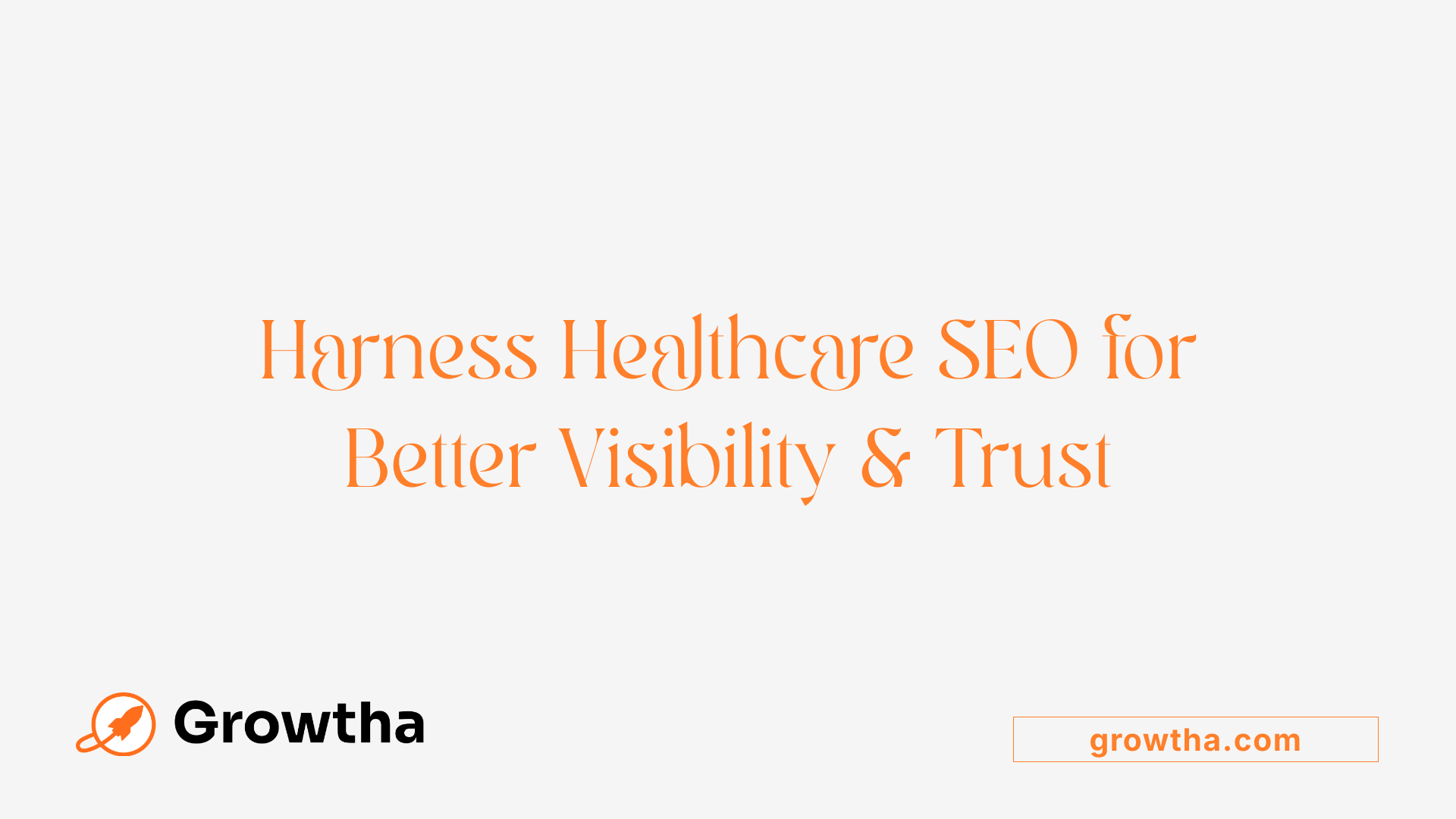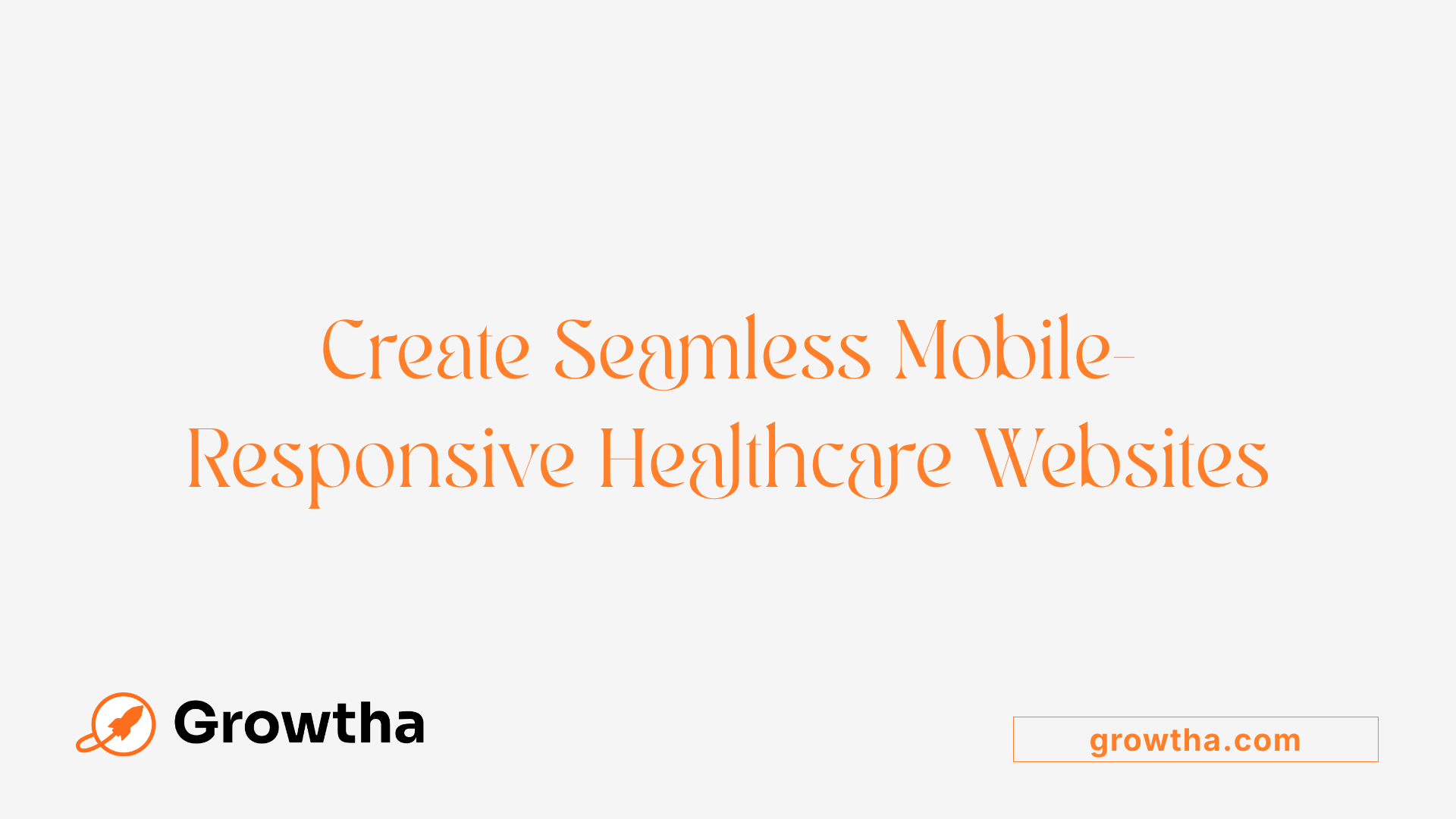Mobile SEO Tips for Healthcare Businesses
Maximizing Mobile Visibility in Healthcare Search Rankings


Mobile SEO Tips for Healthcare Businesses
Unlocking the Power of Mobile SEO for Healthcare Providers
In today's digital age, healthcare providers must prioritize mobile SEO to reach patients effectively. Over half of health-related searches are performed on mobile devices, making a responsive, fast, and user-friendly website essential for attracting and engaging patients. This article explores comprehensive strategies to optimize healthcare websites for mobile, enhance online visibility, and build trust and authority.
The Significance of Healthcare-Specific SEO Strategies

Why is healthcare-specific SEO strategy important?
Healthcare-specific SEO is vital because it directly influences how easily potential patients can find healthcare providers online. In a digital age where over 80% of patients turn to search engines to research health services, ranking high in search results is essential for visibility. Effective strategies include local SEO techniques, which optimize for geographic-specific searches, and keyword optimization tailored to common patient queries such as ‘urgent care near me’ or ‘telehealth services’.
High-quality content that is accurate, verified, and compliant with medical standards helps build authority and trust. This is especially important since Google evaluates healthcare content based on E-E-A-T principles — experience, expertise, authority, and trustworthiness.
Moreover, adhering to strict regulations like HIPAA and ensuring website transparency and security enhances credibility and compliance, which search engines favor. These combined efforts increase organic traffic, attract local patients, and improve a healthcare practice’s online reputation.
Investing in healthcare SEO is not just about visibility; it’s about establishing a reputable presence that patients rely on when making health decisions. This targeted approach supports long-term growth, helps practices stay competitive, and ensures they connect effectively with their community.
By focusing on relevant keywords, accurate content, and local visibility, healthcare-specific SEO strategies ensure that medical providers attract the right audience, foster trust, and ultimately improve patient engagement. In a competitive environment, tailored healthcare SEO efforts are essential for sustained success and growth.
Designing Mobile-Responsive Healthcare Websites

Responsive design best practices
Creating a healthcare website that is mobile-responsive is essential in today's digital landscape. Responsive design ensures that the site automatically adjusts its layout and content to fit various screen sizes, from smartphones to tablets and desktops. For healthcare providers, this means patients can easily access information whether they are at home or on the go.
Implementing flexible grid layouts and scalable images helps maintain a clean, accessible appearance across all devices. Using CSS media queries allows customization of styles based on device characteristics, enhancing user experience. Consistency in font sizes, button sizes, and touch targets ensures ease of navigation and interaction for users on mobile devices.
Optimizing images and reducing redirects for fast load times
Website speed is a major ranking factor and a crucial component of mobile UX. To achieve fast load times, healthcare sites should optimize images by compressing files without compromising quality. Lazy loading images that are outside the viewport can also improve initial page load speed.
Minimizing redirects is another vital step. Excessive redirects can slow down a site and frustrate users. Removing unnecessary redirects and ensuring direct links load quickly improves overall performance. Utilizing Content Delivery Networks (CDNs) distributes content closer to users, further speeding up load times.
Streamlined navigation and accessible content
Navigation must be simple, intuitive, and accessible. Healthcare websites should feature a clear menu structure, with easily clickable links to key sections such as services, patient portals, contact info, and location details. Incorporating a sticky menu or a collapsible hamburger menu keeps navigation accessible on small screens.
Accessibility is also critical, adhering to standards like WCAG 2 Level AA. This includes providing text alternatives for images, ensuring sufficient color contrast, and designing for keyboard navigation. Clear headings, readable fonts, and concise content help users find what they need quickly. Incorporating accessible design not only broadens reach but also aligns with legal and ethical standards.
By combining these best practices—responsive design, optimized images, fast load times, streamlined navigation, and accessibility—healthcare providers can significantly improve their mobile SEO, attract more local patients, and build trust with their community.
Improving Search Rankings for Healthcare Practices on Mobile
How can healthcare practices improve their mobile search rankings?
With the majority of health-related queries happening via smartphones, optimizing for mobile is vital for healthcare providers aiming to attract local patients. To achieve higher search rankings on mobile devices, practices should focus on comprehensive technical SEO strategies.
First, site speed is paramount. Google recommends websites load in under two seconds, which can be accomplished through image optimization, leveraging browser caching, and minimizing code. Fast-loading sites provide a better user experience and are favored in search rankings.
Ensuring your website is mobile-friendly involves adopting a responsive design that adjusts seamlessly to various screen sizes. This includes touch-friendly navigation, legible fonts, and easily clickable buttons. A responsive layout not only improves usability but also aligns with Google's mobile-first indexing approach.
Structured data markup, such as schema.org, enhances search result listings with rich snippets. For healthcare providers, implementing schema for medical facilities, reviews, and services allows your practice to stand out and convey essential information directly in the search results.
Creating authoritative, accurate, and current content authored or reviewed by qualified healthcare professionals boosts trustworthiness and aligns with Google’s E-E-A-T (Experience, Expertise, Authority, Trustworthiness) standards. Well-researched content increases relevance and encourages engagement.
Building high-quality backlinks from reputable healthcare sites, local directories, and community organizations further improves your site’s authority and visibility. These links signal trust to search engines, especially important in competitive local markets.
Optimizing for local SEO by maintaining accurate Google My Business listings enriches your profile with current contact information, reviews, images, and business hours. Local keywords incorporated into your website content, meta tags, and headings also help attract nearby patients searching for healthcare services.
Enhancing user experience through clear navigation, accessible design, and compelling calls-to-action encourages visitors to book appointments or contact your practice. These metrics—dwell time, bounce rate, and conversion rate—are crucial performance indicators monitored via tools like Google Search Console.
Lastly, consistently tracking your SEO performance and making data-driven adjustments ensures sustained visibility. Focus on core web vitals, organic traffic, and ranking reports to adapt your strategies in response to evolving algorithms and patient behaviors.
By integrating these technical and content strategies, healthcare practices can significantly improve their mobile search rankings, increase visibility in local search results, and attract more patients efficiently.
Boosting Online Visibility and Reputation through SEO
What strategies can help healthcare providers enhance their online visibility and reputation through SEO?
Healthcare providers seeking to improve their online presence should prioritize several effective SEO tactics. First, focusing on local SEO is essential. This includes claiming and regularly updating their Google My Business (GMB) profile with accurate, complete information such as address, contact details, hours, and service descriptions. Encouraging satisfied patients to leave positive reviews on GMB and other review platforms like Healthgrades, Yelp, and RateMDs can significantly influence local search rankings and build trust.
Another vital aspect is content creation rooted in the E-A-T principles—Experience, Expertise, Authority, and Trustworthiness. Producing high-quality, authoritative content about health topics, procedures, or conditions not only educates patients but also helps establish credibility. Incorporating references from reputable sources and ensuring content is regularly updated aligns with Google’s standards for YMYL (Your Money or Your Life) pages.
Technical SEO enhancements also play a crucial role. Improving website speed, ensuring mobile responsiveness, implementing HTTPS security, and adding structured data markup (schema) help search engines crawl and index sites effectively while providing a smooth user experience.
Additionally, building backlinks from reputable healthcare websites, community organizations, and local directories boosts domain authority. Maintaining active engagement on social media platforms and sharing valuable content can reinforce online presence.
Lastly, actively managing the online reputation through monitoring reviews, responding promptly to feedback, and addressing any concerns positively impacts trust and credibility. These combined strategies help healthcare organizations stand out in search results, attract new patients, and foster a trustworthy reputation.
Content Optimization for Healthcare Audiences
To effectively reach and engage healthcare audiences online, providers must focus on the relevance, accuracy, and readability of their content. Patients often turn to search engines for trustworthy information, so ensuring the content they find is reliable and easy to understand is vital.
One of the fundamental strategies involves incorporating targeted keywords naturally into page titles, headers, meta descriptions, and throughout the content. This helps search engines recognize the relevance of your pages to specific health topics or local searches, increasing visibility.
Optimized headers not only improve SEO but also enhance user experience by organizing information clearly. Meta descriptions should be concise, compelling, and include relevant keywords to improve click-through rates.
Using multimedia elements like images, videos, and infographics can make complex medical information more digestible, engaging, and shareable. For example, visual content explaining a surgical procedure or symptoms can help demystify healthcare topics and build trust.
Local SEO techniques, such as optimizing your Google My Business profile, including local keywords in your content, and encouraging patient reviews, are crucial for attracting nearby patients. Localized landing pages tailored for specific locations further improve search visibility within the community.
Building content around E-E-A-T principles — emphasizing Experience, Expertise, Authority, and Trustworthiness — involves having qualified professionals review and author your content. Displaying qualifications, certifications, and including credible references from reputable sources reinforces your site's authority and reliability.
Creating a comprehensive content strategy that aligns with organizational goals and addresses patient concerns enhances your online presence. Regularly updating your content ensures accuracy and reflects the latest medical guidelines, further establishing your site as a trustworthy resource.
In summary, optimizing content for healthcare audiences requires a balance of technical SEO best practices and a patient-centric approach. When executed well, it not only improves search rankings but also fosters patient trust and engagement. For more detailed guidance, search for "Content optimization for healthcare websites."
Technical SEO Considerations for Mobile Health Sites
What technical SEO considerations are important for healthcare websites on mobile?
For healthcare websites, optimizing for mobile is essential to ensure patients find accurate and helpful information quickly and easily. Focusing on performance and user experience makes your site more visible and trustworthy.
First, site speed plays a major role. Mobile users expect fast-loading pages. Minimizing file sizes, leveraging browser caching, and using a content delivery network (CDN) can significantly improve load times. Google’s recommended speed is under two seconds, which enhances rankings and reduces bounce rates.
Structured data markup, often called schema, helps search engines understand your content better. For healthcare providers, schema types like "Medical Organization," "Physician," or "Medical Service" provide rich snippets in search results, such as star ratings, reviews, or appointment info. Proper schema implementation boosts visibility in local and voice searches.
Crawlability and URL structure are also vital. Well-organized, logical URLs that include location keywords and service descriptions make it easier for search engines to index your site. Creating a clear site hierarchy with internal links ensures that all important pages are accessible and prioritized.
Accessibility and compliance are more than best practices — they affect your site’s reach and credibility. Adhering to standards like WCAG 2.1 AA ensures inclusive access. Use proper contrast ratios, alt text for images, and responsive design for diverse devices and assistive technologies.
Regular technical audits help to identify issues such as crawl errors, duplicate pages, and broken links. Fixing these ensures a smooth user experience and maintains search rankings.
Implementing a mobile-first responsive design guarantees your website adapts seamlessly to different screen sizes. This not only improves user engagement but also aligns with Google’s mobile-first indexing approach.
Furthermore, local SEO tactics like optimizing Google My Business profiles, adding local keywords, and encouraging patient reviews are crucial for nearby patient acquisition.
In summary, prioritizing fast performance, structured data, clean URL architecture, accessibility, and ongoing technical maintenance builds a solid foundation for healthcare websites to succeed in mobile search results.
Implementing E-E-A-T Principles to Elevate Search Rankings
How does implementing E-E-A-T influence healthcare search rankings?
Implementing the E-E-A-T framework — which stands for Experience, Expertise, Authority, and Trustworthiness — plays a vital role in increasing healthcare website visibility on search engines. Search engines like Google prioritize sites that demonstrate credibility and reliability, especially for health-related content classified as Your Money or Your Life (YMYL).
In practical terms, this means healthcare websites need to clearly showcase qualifications of authors, including detailed bios of medical professionals involved in content creation or review. Publishing content that is accurate, thoroughly researched, and regularly updated aligns with E-E-A-T standards, helping to build trust among both users and search engines.
Building authority is another critical component. This can be achieved through acquiring backlinks from reputable health organizations, medical journals, or authoritative health websites. These links serve as signals of trust and recognition within the medical community.
Furthermore, transparency signals like clear privacy policies, certifications, and positive patient reviews reinforce user trust. Incorporating citations from credible sources and maintaining an open, honest communication policy further elevate a website’s perceived integrity.
A notable example is a healthcare provider that observed improved search rankings after implementing comprehensive E-E-A-T strategies such as expert-authored content, authoritative backlinks, and visible trust signals. This case underscores the framework’s importance in recovering from ranking drops and sustaining high visibility.
In summary, consistent application of E-E-A-T principles not only aligns with Google’s ranking algorithms but also enhances overall user confidence, making it a cornerstone of successful healthcare SEO strategies.
Tools and Resources for Healthcare SEO and Mobile Optimization
 To implement effective healthcare SEO and enhance mobile optimization, various tools and resources are available that cater to different aspects of website performance, search visibility, and user experience.
To implement effective healthcare SEO and enhance mobile optimization, various tools and resources are available that cater to different aspects of website performance, search visibility, and user experience.
Google Search Console and Google Analytics are fundamental free platforms that provide valuable insights into your website’s search performance, visitor behavior, and backlink profiles. These tools help identify areas for improvement and track the impact of SEO strategies.
For more advanced analysis, paid SEO software like SEMrush, Ahrefs, Moz Pro, and Ubersuggest offer comprehensive features such as competitor benchmarking, keyword research tailored to healthcare terms, site audits, and backlinks analysis. These tools enable providers to refine their keyword targeting and monitor their growth over time.
Technical SEO often requires website speed and crawlability improvements. Tools like GTmetrix, Google PageSpeed Insights, and Screaming Frog facilitate site performance reviews, highlighting issues related to load times, mobile responsiveness, and indexing issues. Addressing these factors can boost search rankings, especially on mobile devices.
Local SEO can significantly impact patient acquisition through optimized Google My Business profiles and directories. Platforms such as BrightLocal, Yext, and BirdEye assist healthcare practices in managing consistent NAP (Name, Address, Phone number) data, accumulating reviews, and enhancing visibility in local search results.
Additionally, content optimization tools like Clearscope support crafting relevant, keyword-rich medical content that aligns with search intent. SEO plugins such as Yoast or RankMath embedded in CMS platforms help optimize on-page elements—titles, meta descriptions, headers, and images—further improving mobile and overall search performance.
Collectively, these tools offer a comprehensive suite for healthcare providers to boost their search engine rankings, ensure website technical health, and deliver excellent mobile experiences that attract and retain patients.
Avoiding Common Mobile SEO Mistakes in Healthcare
What common mistakes should healthcare providers avoid in mobile SEO efforts?
Healthcare providers often overlook several critical aspects of mobile SEO that can negatively impact their online visibility and patient engagement.
One of the most frequent errors is neglecting mobile responsiveness and site speed. Websites that are not mobile-friendly may appear broken or difficult to navigate on smartphones, discouraging visitors. Slow-loading pages, caused by unoptimized images or unnecessary scripts, can lead to higher bounce rates, reducing the chance of patient inquiries or appointments.
Additionally, ignoring local SEO and reviews is a common oversight. Many patients search for nearby healthcare providers, so incomplete or inconsistent Google My Business profiles, inaccurate contact details, and lack of local keywords can diminish visibility. Failing to actively manage and respond to patient reviews further undermines trust and search rankings.
Another mistake is overlooking on-page SEO elements. This includes missing or duplicate meta descriptions, unoptimized page titles, and poorly structured headers. Such issues make it harder for search engines to understand and rank website content effectively.
Security and accessibility lapses also pose risks. Websites that do not use HTTPS compromise patient trust and may be penalized by search engines. Moreover, neglecting accessibility standards like WCAG 2 Level AA restricts usability for all users and can harm SEO performance.
To avoid these pitfalls, healthcare providers should ensure their websites are fully responsive, load swiftly, and are optimized for local search. Regularly reviewing SEO analytics, updating content, and maintaining secure, accessible sites are crucial steps in providing a seamless mobile experience that builds trust and attracts new patients.
Enhancing User Engagement and Experience via Mobile SEO

How can healthcare websites enhance user experience and engagement through SEO?
Healthcare websites can significantly improve user experience and boost engagement by adopting a comprehensive SEO approach that prioritizes user-centric features. High-quality, medically accurate content such as health guides, FAQs, and patient stories makes information accessible and trustworthy. Incorporating multimedia elements like videos, infographics, and interactive health tools encourages users to spend more time on the site and facilitates better understanding of complex medical topics.
Implementing local SEO strategies is also crucial. Optimizing Google My Business profiles, including accurate contact info, business hours, and localized keywords, helps attract nearby patients actively searching for healthcare providers. Managing online reviews by encouraging happy patients to leave feedback and promptly responding to reviews builds credibility and fosters trust.
Website design plays a pivotal role. Ensuring fast loading speeds (preferably under two seconds), mobile responsiveness, and easy-to-navigate layouts enhance usability. Clear menus, intuitive buttons, and accessible features make it simple for visitors to find the information they need. Additionally, adhering to accessibility standards such as WCAG 2 Level AA ensures that users with disabilities can access content comfortably.
Structured data markup improves search visibility, enabling rich snippets like ratings and appointment availability to appear in search results. Creating a mobile-first website with responsive design, optimized images, and simplified navigation caters to the high volume of health-related searches conducted on smartphones.
Active engagement also involves integrating interactive tools like appointment schedulers, symptom checkers, and live chat features. These tools facilitate ongoing interaction, support patient decisions, and foster loyalty.
Finally, maintaining a strong social media presence and earning backlinks from reputable health sources reinforces authority. All these elements combined ensure healthcare websites deliver a seamless, trustworthy, and engaging experience—ultimately guiding visitors from awareness to appointment booking and long-term engagement.
Supporting Mobile SEO with General SEO Strategies

What general SEO strategies support mobile optimization for healthcare practices?
Supporting mobile SEO in healthcare means ensuring your website delivers a fast, user-friendly experience on all devices. One of the most important tactics is conducting thorough keyword research focused on local, healthcare-specific terms. This helps you target the exact phrases potential patients search for, whether on smartphones or desktops.
Optimizing your website’s structure is also crucial. An intuitive site hierarchy with logical navigation makes it easier for visitors to find information quickly. Internal linking connects related pages, boosting user engagement and helping search engines understand the site’s content relationships.
Content marketing shouldn't be overlooked. Creating high-quality, authoritative articles, blog posts, and videos that address patient concerns not only builds trust but also encourages sharing across social media. Regularly updating content with relevant keywords and topics keeps the site fresh and relevant, which search engines favor.
Social media engagement can significantly enhance your mobile SEO efforts. Sharing content, gathering patient reviews, and active participation in healthcare communities improve your online visibility and reputation.
Technical SEO forms the backbone of mobile support. Implementing structured data markup (schema), creating XML sitemaps, and securing your website with HTTPS are best practices. These elements ensure your site is easily crawlable, trustworthy, and meets search engines’ technical standards.
Finally, ongoing performance monitoring using tools like Google Search Console and Analytics allows you to track your SEO health. Regular audits help identify issues like slow load times or crawl errors and guide continuous improvements.
By focusing on these combined strategies—keyword targeting, site structure, content marketing, technical improvements, and performance tracking—healthcare providers can effectively support their mobile SEO, increase local visibility, and attract more patients.
Achieving Long-Term Success in Healthcare Mobile SEO
Optimizing healthcare websites for mobile search requires a multifaceted approach that combines responsive design, technical excellence, authoritative content, and strategic local SEO. By focusing on fast load times, intuitive navigation, accurate information, and trust-building elements like reviews, healthcare providers can significantly improve their search rankings and attract more local patients. Continuous monitoring and updating of SEO tactics ensure sustained visibility amid evolving search engine algorithms and patient behaviors. Embracing these comprehensive mobile SEO strategies will ultimately lead to enhanced user engagement, increased credibility, and long-term success in healthcare digital marketing.
References
- Healthcare SEO: how to improve your organic performance
- Healthcare SEO: The Ultimate Guide to Medical SEO - SeoProfy
- Tips for Boosting Your Healthcare SEO Strategy This Year
- SEO For Medical Practices: 6 Best Strategies - ResponseScribe
- How to Use Content Marketing and SEO to Grow Medical Practice
- How to Optimize Healthcare SEO with E-E-A-T Strategies
- 7 Healthcare SEO Ideas & Actions To Heal Your Strategy
- The Ultimate Guide to Healthcare SEO: 3 Techniques Your Website ...







